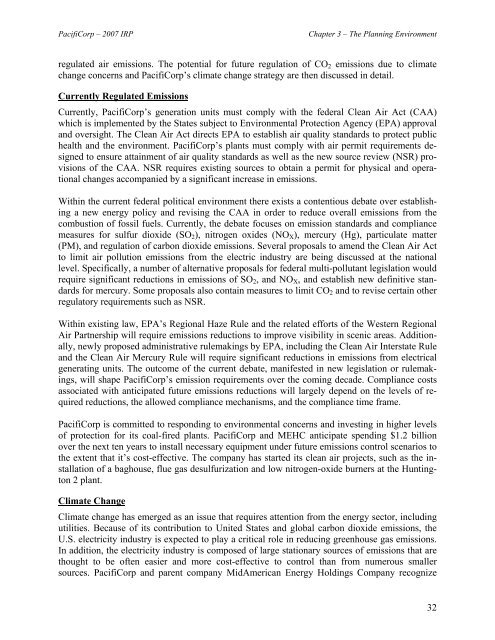PacifiCorp 2007 Integrated Resource Plan (May 30, 2007)
PacifiCorp 2007 Integrated Resource Plan (May 30, 2007)
PacifiCorp 2007 Integrated Resource Plan (May 30, 2007)
Create successful ePaper yourself
Turn your PDF publications into a flip-book with our unique Google optimized e-Paper software.
<strong>PacifiCorp</strong> – <strong>2007</strong> IRPChapter 3 – The <strong>Plan</strong>ning Environmentregulated air emissions. The potential for future regulation of CO 2 emissions due to climatechange concerns and <strong>PacifiCorp</strong>’s climate change strategy are then discussed in detail.Currently Regulated EmissionsCurrently, <strong>PacifiCorp</strong>’s generation units must comply with the federal Clean Air Act (CAA)which is implemented by the States subject to Environmental Protection Agency (EPA) approvaland oversight. The Clean Air Act directs EPA to establish air quality standards to protect publichealth and the environment. <strong>PacifiCorp</strong>’s plants must comply with air permit requirements designedto ensure attainment of air quality standards as well as the new source review (NSR) provisionsof the CAA. NSR requires existing sources to obtain a permit for physical and operationalchanges accompanied by a significant increase in emissions.Within the current federal political environment there exists a contentious debate over establishinga new energy policy and revising the CAA in order to reduce overall emissions from thecombustion of fossil fuels. Currently, the debate focuses on emission standards and compliancemeasures for sulfur dioxide (SO 2 ), nitrogen oxides (NO X ), mercury (Hg), particulate matter(PM), and regulation of carbon dioxide emissions. Several proposals to amend the Clean Air Actto limit air pollution emissions from the electric industry are being discussed at the nationallevel. Specifically, a number of alternative proposals for federal multi-pollutant legislation wouldrequire significant reductions in emissions of SO 2 , and NO X , and establish new definitive standardsfor mercury. Some proposals also contain measures to limit CO 2 and to revise certain otherregulatory requirements such as NSR.Within existing law, EPA’s Regional Haze Rule and the related efforts of the Western RegionalAir Partnership will require emissions reductions to improve visibility in scenic areas. Additionally,newly proposed administrative rulemakings by EPA, including the Clean Air Interstate Ruleand the Clean Air Mercury Rule will require significant reductions in emissions from electricalgenerating units. The outcome of the current debate, manifested in new legislation or rulemakings,will shape <strong>PacifiCorp</strong>’s emission requirements over the coming decade. Compliance costsassociated with anticipated future emissions reductions will largely depend on the levels of requiredreductions, the allowed compliance mechanisms, and the compliance time frame.<strong>PacifiCorp</strong> is committed to responding to environmental concerns and investing in higher levelsof protection for its coal-fired plants. <strong>PacifiCorp</strong> and MEHC anticipate spending $1.2 billionover the next ten years to install necessary equipment under future emissions control scenarios tothe extent that it’s cost-effective. The company has started its clean air projects, such as the installationof a baghouse, flue gas desulfurization and low nitrogen-oxide burners at the Huntington2 plant.Climate ChangeClimate change has emerged as an issue that requires attention from the energy sector, includingutilities. Because of its contribution to United States and global carbon dioxide emissions, theU.S. electricity industry is expected to play a critical role in reducing greenhouse gas emissions.In addition, the electricity industry is composed of large stationary sources of emissions that arethought to be often easier and more cost-effective to control than from numerous smallersources. <strong>PacifiCorp</strong> and parent company MidAmerican Energy Holdings Company recognize32
















